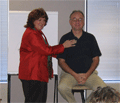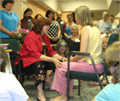



About Qi gong
Qi is usually defined as "vital energy" or "life force." It is the operation and function of Qi in and around the body upon which Oriental medicine is founded. To understand it fully we must think of it as more than a theory or metaphor, but rather as the dynamic, living force which animates, heals and sustains us. Acupuncturists and touch healers treat all sorts of illnesses by relieving blockages and irregularities in the flow of this energy.
Here in the West, we relate this energy mostly to auras and halos, but for thousands of years in the East the effects of Qi and its precise channels in the body have been researched and studied.
Qi Gong (or Ch'i Kung) means any practice or set of exercises for the cultivation of energy and vigor. In its common usage the phrase loosely refers to approximately five thousand different practices.
This vast range of practices covers the entire spectrum from meditative exercises in which one's Qi is manipulated by mind and will, breathing exercises, visualization practices, exercises with moderate, non-strenuous movement, to some physically demanding dance-like exercises and includes the use of vital energy for the healing of others. Thus the term Qi Gong is about as non-specific as the English phrase "physical education."
However, even those exercises which incorporate quite a bit of movement are not the same as physical exercises meant for the development of muscular and cardio-vascular well being and are not a substitute for a sensible physical exercise routine. They are, rather, an exercise routine for one's "vitality muscles."
Qi Gong Practices
Not all Qi Gong is created equal. Out of the many forms we have studied, the following were selected as having the greatest benefit for the human aura and are especially useful for healers:
Practice 1—Xian Gung |
Taking about twenty minutes to perform, this is just about the best overall set for general Qi cultivation. It fills in the human aura in a very balanced way. Those who have never felt physical manifestations of Qi, well might after doing this set of movements. Even if you do not other energy practices, this is the one we recommend and, unlike many other routines, this one can be performed by those who are unable to stand or are bed-ridden. About 20 minutes in length. Available for Internet download in MP4 format (147MB). |
Practice 2—Shaolin Neijin Yizichan |
This routine is appoximately 10 minutes and is of great benefit to the heart chakra. It helps keep the ribcage and shoulders loose and flexible. Because of its energetic relationship to the heart chakra, it is of benefit to people who have concern about heart and lung conditions and helps keep the upper body strong energetically. About 10 minutes in length. Available for Internet download in MP4 format (119MB). |
Practice 3—Eight Treasure |
This is a very short but physically strenuous routine. It builds a pyramid of qi, or energy, from the feet to a point just at the sixth chakra. It is helpful in providing grounding and physical qi before attempting third eye practices. Available for Internet download in MP4 format (80MB). |
> Downlaod our three most popular Qi Gong practices: the Xian Gong (practice 1), Shaolin Neijin Yizichan (practice 2), and the Eight Treasure Good Fortune Pile Stance Exercise (practice 3) — Download All Practices for $24.95